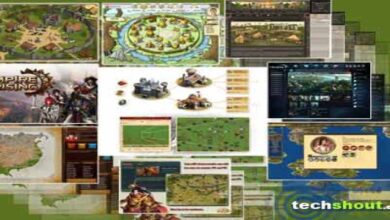Lair of the Idle
A Review of Ruined King: A League of Legends Story
I’ve been holding off on writing about Battle Chasers for almost 3 years because I didn’t have enough screenshots to support it. So this time, with Ruined King, I made sure to take as many pictures as possible. Surprisingly, I ended up with close to 300 shots when I only needed less than 10 for this post.
Riot Games, after dedicating most of their time to balancing Summoner’s Rift, has finally spread its wings and ventured into different game genres. From the success of Arcane to the development of Valorant and even a fighting game, they have proven their expertise in creating diverse experiences. Ruined King, a part of their multimedia franchises, was a highly anticipated addition to the League of Legends universe. Developed by Airship Syndicate, the game had been under the radar for a while until its recent release. I had to wait for over a year before I finally got my hands on it when it went on sale 2 months ago. While Ruined King surpasses Battle Chasers in many aspects, a few issues prevent it from being truly unforgettable.
Presentation

Let’s start with the first and most remarkable accomplishment of Ruined King: the stunning portrayal of Bilgewater. Bilgewater, the pirate town in League of Legends, was previously only explored through text and lore. However, Airship Syndicate brought this locale to life with its multi-tiered elevations, bustling streets, fish markets, and bustling ports. Bilgewater is exactly what I hoped Harm’s Way from Battle Chasers would be—a town where you can physically travel through different areas on foot. Unlike the overworld in Battle Chasers, with its long distances between facilities like Blacksmithing, Monster Hunting Boards, and Shops, Bilgewater offers a faster travel system and separates the services into distinct areas. Though limited to four sections of town, I appreciated the opportunity to explore the entire locale. The game occasionally treats you with breathtaking vistas that showcase the places you can visit.

Bilgewater is only one half of the game’s locale. The other half is the Shadow Isles, which was introduced in the Ruination event in League of Legends. Like Bilgewater, the Shadow Isles was previously explored through text and lore. However, the revamped Twisted Treeline introduced some aspects of the Shadow Isles. In Ruined King, the Shadow Isles reveal their dark secrets as you venture into this cursed land. I have to commend Airship Syndicate for their significant improvement in graphics compared to Battle Chasers.
Plot
The story of Ruined King takes place shortly after the events of the Burning Tide. Miss Fortune, the leader of Bilgewater, eliminates Gangplank’s ship, effectively putting an end to the infighting among the gangs. However, a new threat emerges as Mist Walkers start appearing, wreaking havoc in Bilgewater. Illaoi receives a vision and, together with Braum, goes on a mission to investigate the Shadow Isles. They are joined by Yasuo, who had arrived in Bilgewater with Ahri but had separated from her.

The storyline in Ruined King is relatively straightforward, and while I’m uncertain if Viego’s past was fully explored in the MOBA, I did learn a few things about the champions through this game. The side quests in Ruined King add an interesting element to the story, capturing the cutthroat nature of Bilgewater. I particularly enjoyed the quest where I was tricked into opening a chest in a back alley, only to find myself in a challenging encounter. The game offers a significant number of side quests, which is to be expected given the vast spaces of Bilgewater and the Shadow Isles.
Gameplay

Ruined King not only looks better than Battle Chasers, but it also expands on its gameplay mechanics. The most significant changes are the introduction of the Lane System and the Ultimate Bar. In combat, all attacks, except for the first tab of Instant Attacks, take up space in the turn-order. Abilities that spend mana or overcharge are automatically placed on the Balance Lane. You can choose to sacrifice an ability’s power for quicker activation by placing it in the Speed Lane, or sacrifice time for greater power by placing it in the Power Lane. The Lane System adds depth and strategy to combat, as some enemies require specific abilities placed in certain lanes to deal damage or remove buffs.
The Ultimate Bar allows each character to unleash powerful ultimate abilities after building up the bar during fights. Unlike in Battle Chasers, the Ultimate Bar does not carry over between fights, so it’s best to use it whenever possible.

In terms of traversal and exploration, Ruined King introduces a significant change compared to Battle Chasers. Champion abilities, which were limited by mana or a fixed number of uses in dungeons, are now infinitely usable during map traversal. This frequent ability usage adds more depth to initiating combat, as each ability debuffs enemies in different ways at the start of battle.
Ruined King maintains the challenging nature of Battle Chasers, where careful management of mana or overcharge is necessary after each fight. However, around the midway point of the game, perks and traits are unlocked, making combat more manageable. The perk system in Ruined King works similarly to Battle Chasers, but with the addition of two mechanics. Champion abilities, including basic attacks, can be upgraded twice, splitting into two branches. Additionally, runes can be equipped to enhance stats, abilities, and the Lane System. Both ability upgrades and runes allow for flexible customization of characters’ combat roles.

The Fishing Mini-Game, which was present in Battle Chasers, makes a return in Ruined King. However, unlike before, you no longer need to travel long distances to trade in your fish for rewards. Four fishing spots are conveniently accessible throughout the larger map, allowing you to choose where you want to fish.
User Interface and Progression

Ruined King adopts a more open-world structure compared to Battle Chasers. The game features a detailed map that keeps track of collected lore and treasure chests. The map also includes the quest log, which separates main objectives, side quests, and bounties. Bounties, which replace the monster hunting side quests from Battle Chasers, can be accessed through the Bounty Board in Bilgewater.
Enchanting weapons and armor in Ruined King no longer require specific vendors. Instead, you can enchant your gear directly from the menu screen. You also have the ability to upgrade gear rarity in designated areas, a similar mechanic to Battle Chasers.
The dungeons in Ruined King offer structured exploration, as opposed to the randomly generated dungeons in Battle Chasers. Backtracking is common in Ruined King, but Airship Syndicate ensures that certain areas replace weaker enemies with stronger variants as you progress through the game. I appreciated this attention to detail, as it keeps encounters challenging and prevents backtracking from becoming monotonous. Additionally, there are numerous rest points where you can engage in conversations between party members, adding further depth to the characters and their relationships. These scenes can also be replayed at any rest point.

My initial assumption was that Ruined King would be much shorter than it turned out to be. I was pleasantly surprised by the game’s extensive content. Even though the UI improvements and lack of dungeon replayability caused me to finish Ruined King approximately 10 hours earlier than Battle Chasers, the game still offers a substantial playtime.
Lastly, I appreciated the numerous references to League of Legends in the equippable items. Seeing familiar names like Randuin’s Omen, Bilgewater Cutlass, and Youmu’s Ghostblade added a nostalgic touch to the game.
Gripes

Despite all the improvements, I found myself enjoying Battle Chasers slightly more than Ruined King. As an original RPG, Battle Chasers had more novel elements that stuck with me. While Ruined King is a worthy successor, it lacks some of the cool ideas that made Battle Chasers stand out. One glaring issue I had was the reskinning of enemy models, which felt excessive. It was especially disappointing to see the pugilist enemy model from Battle Chasers reused across multiple variants in Ruined King’s locales.
Furthermore, the game suffered from numerous bugs that significantly impacted my enjoyment. While I can’t recall any major bugs from Battle Chasers, Ruined King had some annoying ones. For instance, there was a UI glitch that prevented the enchanting table in the Shadow Isles’ Drowned Port from registering. Additionally, a key item necessary for unlocking the enchantment table in the Vessani Vault did not drop. I also encountered situations where opening a secret chest repeatedly granted double the loot or checking a cargo shipment during a quest triggered a repeated boss fight.
Overall

Ruined King is undeniably an upgrade from Battle Chasers in terms of world exploration, ability customization, UI, and combat. The incorporation of League of Legends elements adds both strength and weakness to the game. While the Runeterra universe provides an interesting political and character-based narrative, it lacks the complexity of a diverse bestiary. The reskinned enemy types do become monotonous after a while. Nevertheless, the game remains visually captivating, thanks to Joe Mad’s art style and the top-notch cut-ins, models, and comic book-style cutscenes.
One factor that made Battle Chasers charming was its unique flavor text, which added depth to its own universe. While Ruined King includes flavor text and in-game references to League of Legends, it lacks the same RPG campiness that made Battle Chasers so enjoyable.
Sadly, the presence of bugs was also a significant drawback. Not being able to access the final tier of enchantments due to a missing item drop, along with UI bugs during combat, dampened my experience. Accidentally defending when I intended to attack due to UI glitches particularly annoyed me. Despite these negatives, Ruined King is still a worthwhile game to play through, especially if you’re interested in exploring more of the League of Legends universe beyond the MOBA game. The game’s ending doesn’t leave much room for a sequel, except for the mention of Noxus as the destination for Braum and Yasuo, a place that has been hinted at for a while.



![Survivor.io Tier List: Best Weapons & Skills[September 2023]](https://chineseportal.net/wp-content/uploads/2023/09/survivor-io-all-evo-weapons-1-390x220.jpg)